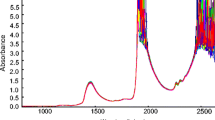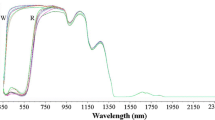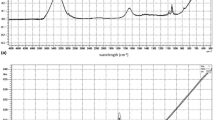Abstract
The purpose of this paper is to use absorbance data obtained by human tasting and an ultraviolet-visible (UV-Vis) scanning spectrophotometer to predict the attributes of grape juice (GJ) and to classify the wine’s origin, respectively. The approach combined machine learning (ML) techniques with spectroscopy to find a relatively simple way to apply them in two stages of winemaking and help improve the traditional wine analysis methods regarding sensory data and wine’s origins. This new technique has overcome the disadvantages of the complex sensors by taking advantage of spectral fingerprinting technology and forming a comprehensive study of the employment of AI in the wine analysis domain. In the results, Support Vector Machine (SVM) was the most efficient and robust in both attributes and origin prediction tasks. Both the accuracy and F1 score of the origin prediction exceed 91%. The feature ranking approach found that the more influential wavelengths usually appear at the lower end of the scan range, 250 nm (nanometers) to 420 nm, which is believed to be of great help for selecting appropriate validation methods and sensors to extract wine data in future research. The knowledge of this research provides new ideas and early solutions for the wine industry or other beverage industries to integrate big data and IoT in the future, which significantly promotes the development of ’Smart Wineries’.
Access this chapter
Tax calculation will be finalised at checkout
Purchases are for personal use only
Similar content being viewed by others
References
Aich, S., Al-Absi, A.A., Lee Hui, K., Sain, M.: Prediction of quality for different type of wine based on different feature sets using supervised machine learning techniques. In: 2019 21st International Conference on Advanced Communication Technology (ICACT), pp. 1122–1127 (2019)
Beaver, C., Collins, T.S., Harbertson, J.: Model optimization for the prediction of red wine phenolic compounds using ultraviolet-visible spectra. Molecules (Basel, Switzerland) 25(7) (2020)
Beltrán, N., Duarte-Mermoud, M., Soto Vicencio, V., Salah, S., Bustos, M.: Chilean wine classification using volatile organic compounds data obtained with a fast gc analyzer. IEEE Trans. Instrum. Meas 57(11), 2421–2436 (2008)
Blanco, V.Z., Auw, J.M., Sims, C.A., O’Keefe, S.F.: Effect of Processing on Phenolics of Wines, pp. 327–340. Springer, US, Boston, MA (1998). https://doi.org/10.1007/978-1-4899-1925-0_27
Castillo-Valero, J.S., Villanueva, E.C., García-Cortijo, M.C.: Regional reputation as the price premium: estimation of a hedonic model for the wines of castile-la mancha. Revista de la Facultad de Ciencias Agrarias 50(2), 293–310 (2018)
Chase, J., Charles, W.: Machine learning is changing demand forecasting. J. Bus. Forecasting 35(4), 43–45 (2016)
Costa, N.L., Llobodanin, L.A.G., Castro, I.A., Barbosa, R.: Finding the most important sensory descriptors to differentiate some vitis vinifera l. south american wines using support vector machines. European Food Res. Technol. 245(6), 1207 (2019)
Costa, N.L.d., Ximenez, J.P.B., Rodrigues, J.L., Barbosa, Jr., F., Barbosa, R.: Characterization of cabernet sauvignon wines from california: determination of origin based on icp-ms analysis and machine learning techniques. European Food Res. Technol. 246(6), 1193 (2020)
Cozzolino, D., Kwiatkowski, M., Waters, E., Gishen, M.: A feasibility study on the use of visible and short wavelengths in the near-infrared region for the non-destructive measurement of wine composition. Anal. Bioanal. Chem. 387(6), 2289 (2007)
Er, Y., Atasoy, A.: The classification of white wine and red wine according to their physicochemical qualities. Int. J. Intell. Syst. Appli. Eng. 4, 23–23 (2016). https://doi.org/10.18201/ijisae.265954
Fuentes, S., Tongson, E., Viejo, C., Torrico, D.: Machine learning modeling of wine sensory profiles and color of vertical vintages of pinot noir based on chemical fingerprinting, weather and management data. Sensors (Switzerland) 20(13) (2020)
Geană, E.I., Ciucure, C.T., Apetrei, C., Artem, V.: Application of spectroscopic uv-vis and ft-ir screening techniques coupled with multivariate statistical analysis for red wine authentication: Varietal and vintage year discrimination. Molecules 24(22) (2019)
Hinojosa-Nogueira, D., Pérez-Burillo, S., Ángel Rufián-Henares, J., Pastoriza de la Cueva, S.: Characterization of rums sold in spain through their absorption spectra, furans, phenolic compounds and total antioxidant capacity. Food Chemistry 323 (2020)
Kerslake, F., Longo, R., Dambergs, R.: Discrimination of juice press fractions for sparkling base wines by a UV-Vis spectral phenolic fingerprint and chemometrics. In: MDPIAG (2018)
Kumar, S., Kraeva, Y., Kraleva, R., Zymbler, M.: A deep neural network approach to predict the wine taste preferences. In: Solanki, V.K., Hoang, M.K., Lu, Z.J., Pattnaik, P.K. (eds.) Intelligent Computing in Engineering. AISC, vol. 1125, pp. 1165–1173. Springer, Singapore (2020). https://doi.org/10.1007/978-981-15-2780-7_120
Kumar, S., Agrawal, K., Mandan, N.: Red wine quality prediction using machine learning techniques. In: 2020 International Conference on Computer Communication and Informatics (ICCCI), pp. 1–6 (2020)
Lawless, H.T., Heymann, H.: Sensory Evaluation of Food. FSTS, Springer, New York (2010). https://doi.org/10.1007/978-1-4419-6488-5
Liu, H., Li, Q., Yan, B., Zhang, L., Gu, Y.: Bionic electronic nose based on mos sensors array and machine learning algorithms used for wine properties detection. Sensors (Switzerland) 19(1) (2019)
Longo, R., Blackman, J.W., Antalick, G., Torley, P.J., Rogiers, S.Y., Schmidtke, L.M.: Volatile and sensory profiling of shiraz wine in response to alcohol management: comparison of harvest timing versus technological approaches. Food Res. Int. 109, 561–571 (2018)
Longo, R., Dambergs, R.G., Westmore, H., Nichols, D.S., Kerslake, F.L.: A feasibility study on monitoring total phenolic content in sparkling wine press juice fractions using a new in-line system and predictive models. Food Control 123, 106810 (2021). https://doi.org/10.1016/j.foodcont.2019.106810
Martelo-Vidal, M., Vázquez, M.: Determination of polyphenolic compounds of red wines by uv-vis-nir spectroscopy and chemometrics tools. Food Chem. 158, 28–34 (2014)
Palmer, J., Chen, B.: Wineinformatics: Regression on the grade and price of wines through their sensory attributes. Fermentation 4(4), 84 (2018)
Rodríguez-Méndez, M., et al.: Electronic noses and tongues in wine industry. Front. Bioeng, Biotechnol. 4 (2016)
Sáenz-Navajas, M.P., et al.: Modelling wine astringency from its chemical composition using machine learning algorithms: Special macrowine 2018 (sarragosse). OENO One 53 (2019)
Thakkar, K., Shah, J., Prabhakar, R., Narayan, A., Joshi, A.: Ahp and machine learning techniques for wine recommendation (2016)
Trivedi, A., Sehrawat, R.: Wine quality detection through machine learning algorithms. In: ICRIEECE, pp. 1756–1760 (2018)
Urbano, M., Luque de Castro, M.D., Pérez, P.M., García-Olmo, J., Gómez-Nieto, M.A.: Ultraviolet-visible spectroscopy and pattern recognition methods for differentiation and classification of wines. Food Chem. 97(1), 166–175 (2006)
Viejo, C., Torrico, D., Dunshea, F., Fuentes, S.: Emerging technologies based on artificial intelligence to assess the quality and consumer preference of beverages. Beverages 5(4), 62 (2019)
Author information
Authors and Affiliations
Corresponding author
Editor information
Editors and Affiliations
Rights and permissions
Copyright information
© 2023 The Author(s), under exclusive license to Springer Nature Singapore Pte Ltd.
About this paper
Cite this paper
Yao, J., Tran, S.N., Nguyen, H., Sawyer, S., Longo, R. (2023). Wine Characterisation with Spectral Information and Predictive Artificial Intelligence. In: Tanveer, M., Agarwal, S., Ozawa, S., Ekbal, A., Jatowt, A. (eds) Neural Information Processing. ICONIP 2022. Communications in Computer and Information Science, vol 1794. Springer, Singapore. https://doi.org/10.1007/978-981-99-1648-1_21
Download citation
DOI: https://doi.org/10.1007/978-981-99-1648-1_21
Published:
Publisher Name: Springer, Singapore
Print ISBN: 978-981-99-1647-4
Online ISBN: 978-981-99-1648-1
eBook Packages: Computer ScienceComputer Science (R0)




